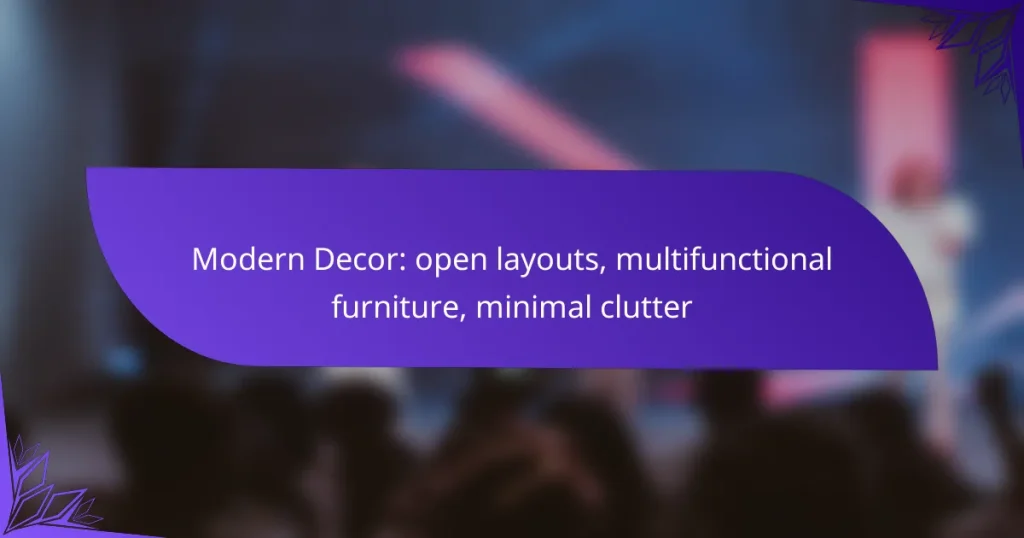Modern decor emphasizes open layouts that foster connectivity and maximize functionality, creating inviting spaces filled with natural light. By incorporating multifunctional furniture, such as convertible sofas and storage solutions, you can efficiently utilize smaller areas while maintaining a stylish aesthetic. Additionally, minimizing clutter through organized storage and a minimalist approach further enhances the overall appeal of your home.

How to create open layouts in modern decor?
Creating open layouts in modern decor involves designing spaces that promote flow and connectivity while maximizing functionality. This approach often includes using multifunctional furniture, large windows for natural light, and cohesive color schemes to enhance the overall aesthetic.
Use furniture placement for flow
Strategic furniture placement is essential for achieving an open layout. Arrange furniture to create clear pathways and encourage movement throughout the space. For example, avoid blocking walkways with large pieces and instead use smaller, movable items to maintain an airy feel.
Consider using furniture that serves multiple purposes, such as ottomans that can be used for seating or storage. This not only saves space but also enhances the flow by reducing clutter and allowing for more flexible arrangements.
Incorporate large windows for natural light
Large windows are a key element in modern decor, as they invite natural light into the space, making it feel larger and more inviting. When planning your layout, prioritize window placement to maximize daylight exposure, which can significantly enhance the ambiance.
Using sheer or light-filtering window treatments can further enhance this effect, allowing light to diffuse softly throughout the room. This approach not only brightens the space but also creates a sense of openness and connection to the outdoors.
Utilize color schemes for visual continuity
A cohesive color scheme is vital for creating an open layout that feels unified. Stick to a limited palette of complementary colors to maintain visual continuity across different areas. Neutral tones often work well as a base, allowing for pops of color through accessories or artwork.
Consider using similar shades for walls, furniture, and decor items to create a seamless transition between spaces. This technique helps to visually expand the area and reduces the feeling of clutter, making the layout feel more spacious and organized.

What multifunctional furniture options are available?
Multifunctional furniture maximizes space and utility, making it ideal for modern decor. Options like Murphy beds, convertible sofas, and storage ottomans provide practical solutions for smaller living areas while enhancing style.
Murphy beds for space-saving
Murphy beds, or wall beds, fold up into a wall or cabinet when not in use, freeing up floor space. They are perfect for studio apartments or guest rooms, allowing you to convert a living area into a bedroom effortlessly.
When selecting a Murphy bed, consider the mechanism’s ease of use and the bed’s size. Many models come with integrated shelving or desks, adding even more functionality. Ensure the installation is secure to avoid safety issues.
Convertible sofas for versatility
Convertible sofas serve as both seating and sleeping areas, making them a great choice for multifunctional spaces. They can transform from a stylish couch into a bed, accommodating guests without needing a separate guest room.
Look for models with durable materials and easy-to-use mechanisms. Some convertible sofas also include storage compartments, which can help reduce clutter. Check the dimensions to ensure it fits comfortably in your space.
Storage ottomans for dual purpose
Storage ottomans provide both seating and hidden storage, making them a practical addition to any room. They can be used as footrests, extra seating, or even as coffee tables, depending on your needs.
Choose ottomans with sturdy construction and a design that complements your decor. They can hold items like blankets, books, or games, helping to keep your space organized. Be mindful of the size to ensure they fit well within your layout.

How to minimize clutter in modern spaces?
Minimizing clutter in modern spaces involves utilizing efficient storage solutions, embracing a minimalist decor style, and maintaining regular organization habits. By focusing on these strategies, you can create a more open and inviting environment that enhances functionality.
Implement smart storage solutions
Smart storage solutions are essential for reducing clutter in modern spaces. Consider using multifunctional furniture, such as ottomans with hidden compartments or beds with built-in drawers, to maximize available space. Wall-mounted shelves can also help keep items off the floor while displaying decor.
Incorporate vertical storage options like tall bookcases or pegboards to utilize wall space effectively. Baskets and bins can help organize smaller items, making it easier to maintain a tidy appearance. Aim for a balance between accessibility and aesthetics when selecting storage solutions.
Adopt a minimalist approach to decor
A minimalist approach to decor emphasizes simplicity and functionality, which helps reduce visual clutter. Choose a few key decorative pieces that resonate with you and avoid overcrowding surfaces with unnecessary items. Neutral color palettes can also create a sense of calm and spaciousness.
When selecting decor, prioritize quality over quantity. Invest in timeless pieces that complement your space rather than trendy items that may quickly become outdated. This approach not only minimizes clutter but also enhances the overall design of your home.
Regularly declutter and organize
Regular decluttering and organizing are crucial for maintaining a clutter-free environment. Set aside time weekly or monthly to evaluate your belongings and remove items that no longer serve a purpose. Consider the “one in, one out” rule: for every new item you bring into your space, remove an existing one.
Establish designated areas for frequently used items to streamline organization. Use labels on storage containers to make it easy to find what you need without rummaging through clutter. Consistency in your decluttering routine will help sustain a clean and organized modern space.

What are the benefits of open layouts?
Open layouts offer several advantages, including increased natural light, improved social interaction, and a sense of spaciousness. These features make them a popular choice for modern homes and offices, enhancing both aesthetics and functionality.
Enhanced natural light and ventilation
Open layouts maximize the flow of natural light throughout a space, reducing the need for artificial lighting during the day. This can lead to lower energy costs and a more inviting atmosphere.
Additionally, fewer walls allow for better air circulation, which can improve indoor air quality. Consider using large windows or sliding glass doors to further enhance light and ventilation in your open layout.
Improved social interaction
With fewer barriers, open layouts facilitate communication and connection among family members or colleagues. This design encourages a more collaborative environment, making it easier to engage with others while cooking, working, or relaxing.
To enhance social interaction, incorporate multifunctional furniture that can be easily rearranged for gatherings. For example, a movable island in the kitchen can serve as a dining area or a workspace, promoting flexibility in how the space is used.
Perceived spaciousness
Open layouts create an illusion of more space, making smaller areas feel larger and more expansive. This is particularly beneficial in urban settings where square footage may be limited.
To maintain this sense of openness, avoid overcrowding the space with furniture. Instead, choose sleek, multifunctional pieces that serve multiple purposes without taking up too much room. Neutral color palettes and strategic lighting can also enhance the feeling of spaciousness.

Which brands offer multifunctional furniture?
Several brands specialize in multifunctional furniture, providing innovative solutions for maximizing space in modern decor. These brands cater to various budgets and styles, making it easier to find the right fit for your home.
IKEA for affordable options
IKEA is well-known for its budget-friendly multifunctional furniture, offering a wide range of products that combine style and practicality. Items like sofa beds, extendable dining tables, and storage ottomans are designed to serve multiple purposes, making them ideal for small spaces.
When shopping at IKEA, consider the assembly requirements and the size of the items to ensure they fit your space. Their products often come with clear instructions and can be customized with various accessories to enhance functionality.
West Elm for stylish designs
West Elm focuses on stylish, modern multifunctional furniture that doesn’t compromise on aesthetics. Their offerings include chic coffee tables that convert into dining tables and elegant shelving units that serve as room dividers.
While West Elm products may be pricier than budget options, they often feature higher-quality materials and unique designs. Look for pieces that complement your existing decor while providing the versatility you need.
Resource Furniture for high-end solutions
Resource Furniture specializes in high-end multifunctional furniture, perfect for those willing to invest in premium quality. Their innovative designs include wall beds that fold away seamlessly and modular systems that adapt to various living situations.
These products often come with advanced mechanisms and customizable options, making them suitable for luxury apartments or homes where space is at a premium. Be prepared for a higher price point, but the investment can significantly enhance your living experience.


